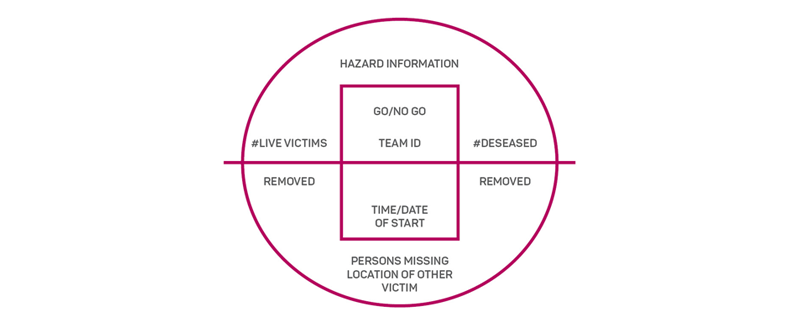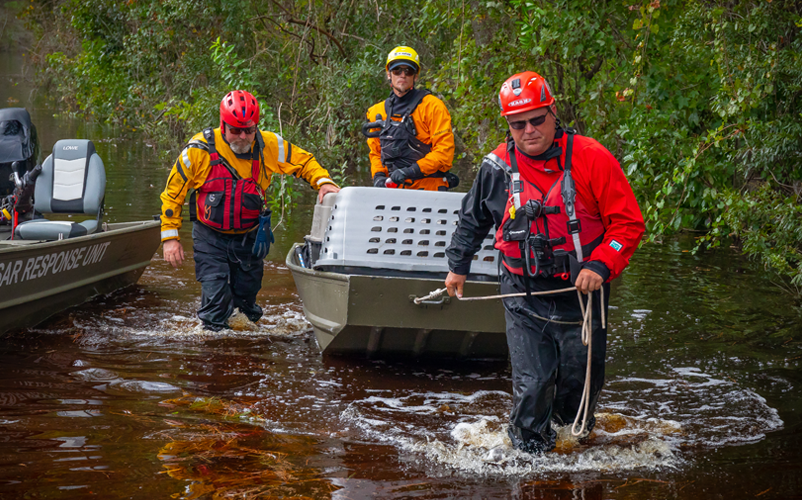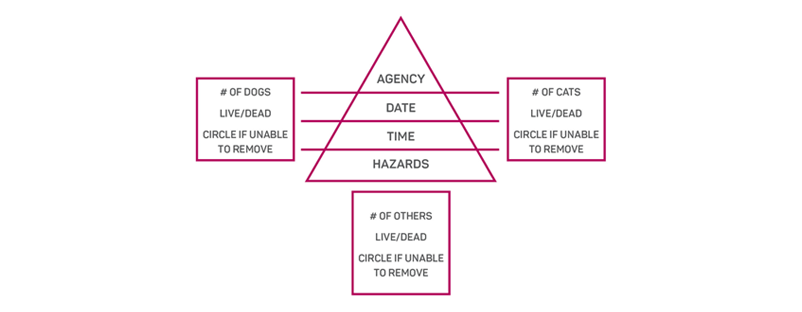When earthquakes and other natural hazards strike, it is not only humans that can become trapped in collapsed structures. This paper details current international practice of structural search markings used after disaster events. It also explores developing search markings to include markings for animals so that rescuers also take note of the presence and status of animals rescued from the location. Historically, companion animal owners have been known to consistently breach cordons to search for their animals. Currently, disaster search marking systems do not accommodate the rescue status of animals being removed or that are still trapped. An animal specific search marking system is recommended and decision makers within search marking bodies should consider adoption or development of such marking systems. The availability of an animal search marking could reduce confusion during human focused rescue efforts and contribute to the legitimisation of technical animal rescue as an independent discipline.
Introduction
The International Search and Rescue Advisory Group (INSARAG) is established under the United Nations. The group oversees guidelines and minimum standards for urban search-and-rescue teams involved in international responses to earthquakes. One of the key outputs of this group is the production of methodologies, including a standardised marking system, to indicate that structures have been searched. These markings indicate the location, or potential location, of victims buried in collapsed structures.
There is a growing trend that animals are becoming an issue for search-and rescue activities. Because search and rescue is an urban discipline that is focused on structural collapse response, teams often come into contact with animals, particularly companion animals, that also need to be rescued. This is in line with increasing public expectation and, in some cases, legal requirements.
INSARAG markings
INSARAG markings have undergone several revisions in the past few years, notably dropping the structural assessment marking (Figure 1) in favour of the worksite marking (Figure 2) and re-introducing the victim marking system (Glassey 2014). However, the current INSARAG victim marking system is not consistent with the Federal Emergency Management Agency (FEMA) equivalent marking system and irregularities include team identification and ‘all victims removed’ indication.
FEMA markings
The United States of America (USA), emergency services organisations do not subscribe to the INSARAG search marking methodology when operating domestically. Instead, they use USA-specific structures and hazards marking (Figure 3) and the search assessment marking system (Figure 4), as determined by FEMA.
In the USA, the FEMA structures and hazard marking is placed on the outside of damaged structures to indicate that the building has been assessed as at either low, medium or high risk of collapse. This is denoted with either no internal line, one diagonal line or two diagonal lines forming a cross, respectively. For example, in Figure 3, a structure has been assessed as at medium risk of collapse by New England Task Force 1 on 28 June 2003. The marking also notes a hazardous material risk of natural gas. An arrow shows the direction to the safety point of entry to the structure (US Army 2016).
The FEMA search assessment marking (Figure 4) is placed on the street-address side of the building. The marking has a diagonal line with a team identifier (i.e. PA-TF1) and date and time of entry is added in the left quadrant. Hazards are noted in the right quadrant. When leaving the structure, the date and time of exit is updated and a second diagonal line is added (to create a cross). Information about any people deceased (D) and living (L) who were removed from the structure are indicated. Other minor variations for this marking are used in reconnaissance of structures where a search is not carried out (US Army 2016).

Figure 1: Former INSARAG Structural Marking (United Nations 2006).

Figure 2: INSARAG Worksite Marking (United Nations 2015).

Figure 3: FEMA Structures and Hazards Marking (US Army 2016).

Figure 4: FEMA Search Assessment Marking (FEMA 2006).
Including markings for animals
Under the USA National Incident Management System (NIMS), response team capability (also known as team typing) and position requirements are specified, now include technical animal rescue. Additionally, requirements to have credentialed animal-rescue personnel was reflected in the 2014 edition of the National Fire Protection Association (NFPA) standard on technical rescue, with animal rescue being legitimised as a new chapter and discipline within this consensus based standard (NFPA 2014). Both the NFPA and NIMS requirements for urban search and rescue responders require such operators to understand the national protocols for searching for people in collapsed structures.
Following Hurricane Katrina in 2005, the USA passed a federal law known as the Pet Emergency and Transportation Standards (PETS) Act of 2006 that made provisions for the rescue, care and accommodation of companion animals rescued during emergency and disaster events. Federal funding covers the costs of companion animal rescue undertaken by urban search and rescue teams within the USA. It is the norm for urban search and rescue (USAR) teams to be actively involved in the rescue of companion animals (Fugate 2019).
In other countries such as Australia and New Zealand, the INSARAG marking systems are adopted. However, an analysis by Glassey (2013) showed their use and meaning were not well understood by users nor within the emergency management sector.
Search markings for confusion
In April 2017, the town of Edgecumbe in New Zealand (population 1700) was flooded when flood-protection walls failed. Responders and the local community worked quickly to evacuate the entire township but approximately 1000 animals were left behind in the cordoned area that contained roughly six-hundred houses. As no humans remained in the evacuated area, animal rescue teams (supported by volunteer response teams) carried out a massive operation to rescue the stranded animals. They applied the INSARAG rapid clearance marking (Figure 5) that requires the marking to be ‘applied in the most visible/logical position on the object to provide the greatest visual impact’ (United Nations 2015, p.90). The INSARAG rapid clearance marking was used to expedite search progress and minimise the damage to property left by marking.
However, local civil defence authorities did not understand the meaning of the marking and incorrectly advised community members that the ‘C’ in the diamond meant the structure was ‘primarily condemned’ (Stuff 2017) when, in fact, the marking showed the structure was ‘clear’ of victims. A corrective public announcement was subsequently issued (Glassey 2017). In addition, some of the markings applied were not compliant with the INSARAG guidelines, with some rapid clearance markings incorrectly marked with a ‘C’ in a triangle.
The application of markings is an emergency power under Section 92 of the New Zealand Civil Defence Emergency Management Act 2002 and is protected under Section 110. However, the permanent markings caused damage to properties and angered some property owners. In the New Zealand Society for the Prevention of Cruelty to Animals (SPCA) report (Glassey 2017), it was recommended that a Low Damage Marking (LDM) system be used for future responses, consistent with earlier recommendations (Glassey 2014). The LDM system provides an alternative to permanent markings such as adhesive labels and waterproof paper stapled to structures. An added benefit of using alternate methods such as label sheets or placards is that they do not create fumes found in aerosol paints. Such paints can adversely affect search dogs undertaking their search activities (US Army 2016, p.25).
Other animal response organisations such as Animal Evac New Zealand produced their own LDM system due to the lack of existing marking systems for structures in regard to animal rescue (Figure 6).
Confusion around search marking systems also occurred during an EF-5 tornado in Greensburg, Kansas in 2007. During this event, it was observed that some responders marked structures clear of victims with a ‘V’, denoting it was ‘vacant’. This conflicted with the FEMA victim marking for an unconfirmed victim location.
These examples suggest that work is needed to educate response personnel on disaster marking systems used in their respective countries. It also suggests that better alignment is required of marking systems between FEMA and United Nations systems.

Figure 5: INSARAG Rapid Clearance Marking.

Figure 6: Animal Evac NZ Rapid Clearance Marking (Glassey & Andrews 2018).
Why animal rescue affects human rescue
A growing trend in urban search and rescue is the consideration of animals, in particular companion animals that are left behind during evacuation or in disaster-affected areas. Studies have highlighted the actions of pet owners who illegally enter or attempt to illegally enter cordon zones to search for and rescue their animals (Day 2017, Glassey & Wilson 2011, Heath 1999, Taylor et al. 2015, Travers, Degeling & Rock 2017, Whittaker & Taylor 2018). Of owners who leave their pets behind, 50–70 per cent are likely to attempt to return to rescue them (Heath 1999). In the 2017 Edgecumbe flood, 54 per cent of pet owners attempted to rescue their animals and 33 per cent illegally breached the cordon area, mostly to rescue their pets and/or retrieve medications (Glassey 2018).
In the context of urban search and rescue incidents, there have been cases of animal owners returning to earthquake damaged structures to save their animals. In the Haiti earthquake in 2010 that caused over 100,000 human deaths, animal owners returned to collapsed structures to search and to rescue their pets (Sawyer & Huertas 2019). This was also the case in 2011 following the earthquake in Christchurch, New Zealand (Potts & Gadenne 2014). This demonstrates the protective behaviour of animal owners that occurs.
The phenomena of pet owners illegally entering a disaster zone highlights the risks such owners are willing to take to protect their animals. As such, unaccountable and untrained members of the public within the cordon place their own safety at risk or risk the safety of rescue and security personnel who may have to intervene to remove them.
In the Edgecumbe floods, a woman was refused entry at the cordon to access her horse. In defiance, she swam across the flooded river unbeknown to safety officials. In effect, the cordon, which was meant to protect human life, negatively influenced this person to put her life at risk. To reduce such behaviour, responders carrying out door-to-door searches in the aftermath of the flood recovered deceased pets and passed them on to the local animal shelter to identify and reunite them with their owners. This removed the motivation of evacuated residents to return to find their pets. The early return of these animals to their owners before extensive degradation of the bodies minimised emotional harm to pet owners.
Animals left behind and trapped in collapsed structures may also create false flags for electronic and canine search teams. False alerts from trapped animals distracts human rescuers at a time when expeditious location and retrieval of people trapped is paramount. Addressing the issues of animal rescue improves the search and rescue of humans.

Specialist animal rescuers evacuate pets during Hurricane Harvey near Texas in 2017. Image: Eric Thompson
Recommendations
The lack of animal-inclusive search markings has been recognised as an issue for some time, both at the international level and within the USA (Glassey 2010, 2017). The lack of animal-inclusive search marking protocols has resulted in an animal-specific disaster search marking (Figure 7) for houses and structures by the Animal Search and Rescue (ASAR) Best Practice Work Group in the USA and is promoted by experts such as Green (2019). The marking is not issued or approved by FEMA, NFPA nor INSARAG but it provides a starting point to promote a common marking system to prevent confusion in the absence of direction on whether disaster search markings can be used for animal search-and-rescue or disaster response groups. However, the marking system is not universally accepted, it conflicts with historical INSARAG symbology and creates another marking system for responders to recognise and understand. Organisations such as FEMA, NFPA and INSARAG have an opportunity to include animal rescue elements in their existing marking systems, which will assist interoperability.

Figure 7. ASAR House Marking.

Figure 8. Proposed ITRA Animal Search Marking.

Figure 9. Draft ITRA Animal Search Marking.

Figure 10. Draft ITRA Animal Search Marking denoting animals remain.

Figure 11. Draft ITRA Animal Search Marking denoting all animals removed.
The ASAR animal search marking is a draft marking system for animal search and rescue as set by the International Technical Rescue Association (ITRA). The revised Animal Search Marking (Figures 8 and 9) is aligned to the former and discontinued INSARAG Search Assessment Marking. The key revision is that the outsides of the primary shape are not species-specific but indicate the rescued-alive, rescued-dead or remain (dead or alive) status of animals at the site. The circle around the primary shape in either the ASAR or ITRA Animal Search Marking and indicates that animals remain on the site or that the site was not fully searched and may require another team with additional capability to undertake the animal rescue or recovery. The horizontal line through the primary shape (Figure 11) indicates that all animals, both alive and deceased, have been removed from the site.
It is recommended the revised Animal Search Marking be adoption or be considered for further refinement by authorities including FEMA and INSARAG.
Conclusion
As greater emphasis is placed on the life of animals (in particular, companion animals) during emergencies and disasters, those leading urban search-and-rescue operations need to evolve search methodologies to reflect public expectations. Moving from a ‘human life first’ to ‘saving pets, saves people’ mentality will improve public confidence during future responses and minimise the compromised safety of pet owners. The introduction of an internationally recognised and interoperable animal search marking system will help with human and animal rescue symbology. This will require leadership and an inclusive approach to urban search and rescue at national and international levels.
There will be advantages in working towards an integrated response between animal rescue responders and USAR (human rescue) operatives given that animal rescue responders are often trained in human rescue and first-aid. Animal rescue responder capacities would act as a force-multiplier to expedite search efforts, reduce the duplication of searches and, ultimately, minimise public anxiety. Animal rescue would benefit from a standardised search marking system to avoid the proliferation of non-universal symbology that would lead to confusion and challenge search efforts.


